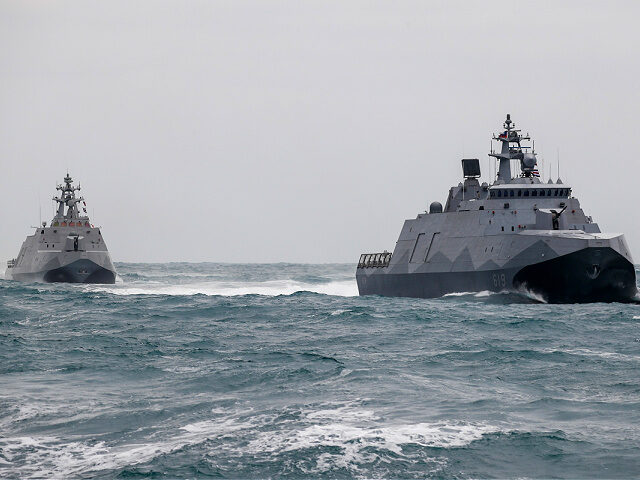The Indian government’s representative office in Sri Lanka used the term “militarization” in a post on Twitter on Saturday to describe China’s recent actions in the Taiwan Strait, which separates the sovereign island nation of Taiwan from China’s southeastern coast, the Hindu reported on Sunday, noting that it was the first time New Delhi had used such strong rhetoric to refer to the China-Taiwan dispute.
“India has for the first time referred to what it called ‘the militarisation of the Taiwan Strait’, marking a rare instance of New Delhi appearing to comment on China’s actions towards Taiwan,” the Indian newspaper reported on August 28.
The Hindu referred to a statement posted by the official Twitter account of the High Commission of India in Colombo, Sri Lanka, on August 27. The Twitter page for the High Commission of India in Sri Lanka describes the office as representing the Indian federal government in its efforts to “promote relations in all spheres between India and Sri Lanka.”
The Spokesman of @IndiainSL issued the above tweets in response to queries concerning the article by Chinese Ambassador to #SriLanka which, inter alia, drew connection between militarization of Taiwan Straits and visit of China’s Yuan Wang 5 ship to Hambantota.
— India in Sri Lanka (@IndiainSL) August 27, 2022
The statement read:
The Spokesman of @IndiainSL issued the above tweets in response to queries concerning the article by Chinese Ambassador to #SriLanka which, inter alia, drew connection between militarization of Taiwan Straits and visit of China’s Yuan Wang 5 ship to Hambantota.
The office referred to “China’s Yuan Wang 5 ship,” which is a Chinese survey vessel that docked in Sri Lanka’s Hambantota Port on August 16 and departed on August 22. The vessel’s arrival in Sri Lanka was delayed by a few days after New Delhi and Washington objected to the action, arguing that it threatened Sri Lanka’s sovereignty and thus, by extension, that of nearby India. The island nation of Sri Lanka is located just 34 miles off India’s southeastern coast at the narrowest point of the Palk Strait.
Colombo handed its Hambantota Port to China’s government on a 99-year lease in 2018 after struggling to pay back an $8 billion loan from Beijing it took out to develop the port and other infrastructure sites. The situation highlighted what observers have described as a form of “debt-trap diplomacy” that China’s ruling Communist Party practices through its Belt and Road Initiative (BRI). The BRI, of which Sri Lanka is a member, allows Beijing to fund infrastructure projects in developing or lower-income countries. Critics argue that the predatory structure of such loans often pushes already indebted nations further into debt to China and thus makes their governments susceptible to political exploitation by the nation’s ruling Communist Party.
“Chinese loans account for about 10% of the nation [Sri Lanka]’s total foreign debt. But since this year, India has also lent about $3.8bn to help Sri Lanka through its economic crisis,” the Guardian observed on August 29.
Among the actions China has taken in the Taiwan Strait that New Delhi described as “militarization” were near-daily flyovers by China’s People’s Liberation Army Air Force (PLAAF). The Chinese air sorties often enter Taiwan’s air defense identification zone (ADIZ), which is a sensitive, buffer-like airspace that exists just outside of a nation’s sovereign airspace. The U.S. Federal Aviation Administration defines an ADIZ as “an area of airspace over land or water, in which the ready identification, location, and control of all aircraft […] is required in the interest of national security.”
China’s military has increasingly ordered such harassment of Taiwan’s ADIZ because of recently increased political tensions between the two entities. Beijing considers Taiwan to be a province of China that will be inevitably “reunified” with China in the future. China’s ruling Communist Party maintains this stance despite Taiwan’s successful operation as an independent nation with a democratically-elected government based on its own constitution.
China recently staged live-fire military drills in the airspace and waters surrounding Taiwan from August 4 to August 7. The action marked a significant escalation in Beijing’s military actions toward the island nation and came in direct response to a visit to Taipei by U.S. House Speaker Nancy Pelosi (D-CA) from August 2 to August 3. The symbolic trip made Pelosi the highest-ranking U.S. government official to visit Taiwan in 25 years, gravely upsetting Beijing.
Neither China’s government nor that of the U.S. officially acknowledges Taiwan’s sovereignty according to the terms of an agreement between Beijing and Washington that allows them to maintain formal diplomatic ties with each other. The deal, known unofficially as the “Taiwan agreement,” is a policy outlining China and America’s relationship with Taiwan. The U.S. officially maintains diplomatic ties with Beijing rather than Taipei in accordance with the agreement.
The U.S. Congress passed the Taiwan Relations Act in 1979, which supports the “Taiwan agreement.” The legislation “makes clear that the U.S. decision to establish diplomatic ties with Beijing instead of Taiwan rests upon the expectation that the future of Taiwan will be determined by peaceful means,” Reuters noted in October 2021.
“While that act binds the United States to provide Taiwan with the means to defend itself, Washington only acknowledges China’s stance that the island belongs to it and that there is ‘one China,’ and takes no position on Taiwan’s sovereignty,” the news agency observed.

COMMENTS
Please let us know if you're having issues with commenting.